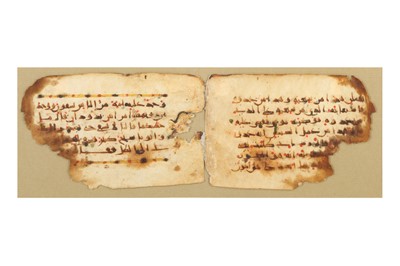28th Oct, 2022 14:00
Islamic & Indian Art
TWO CONJUGATE QUR'ANIC FOLIOS WITH HYBRID SCRIPT
Near East or North Africa, 10th century
TWO CONJUGATE QUR'ANIC FOLIOS WITH HYBRID SCRIPT
Near East or North Africa, 10th century
Arabic manuscript on vellum, Sura Al-Qasas (28), the left folio with aya 23 (5ll. to the page), the right folio with an earlier verse from the same Sura telling the story of Prophet Musa's (Moses) life (7ll. to the page), written in dark sepia ink in hybrid Kufic script, diacritic marks in red, blue and green, the left folio with a tarnished blue and yellow-illuminated palmette on the right margin, the text framed within two narrow decorative bands in yellow, red and blue, mounted, glazed and framed, the folios 8.2cm x 13cm at widest point, 20.5cm x 39cm including the frame.
Provenance: Sotheby's London, 26 April 1991, lot 218.
Parchment folios in horizontal format like ours would have most likely been once part of small multi-volume Qur'ans, which used to be very popular in the 9th and 10th centuries. Every folio usually contained a few lines of text, in our case seven and five respectively, and though illuminations were far from absent, their style tended to be strikingly simple, with discreet verse markers and mostly only red dots for the vocalisation. The focus, thus, was on the Kufic script itself. For further reference, please see M. Fraser and W. Kwiatkowski, Ink and Gold: Islamic Calligraphy, 2006, cat. 11, p. 49.
In the present example, it is worth noting the stylisation of the letters mim, nun and waw. They seem to depart from the Kufic script Déroche identified as Group D (F. Déroche, The Abbasid Tradition: Qur'ans of the 8th to the 10th centuries AD, 1992, pp. 44 - 45). Their contours, usually rounded and curvilinear in other Kufic folios of the same period, show here a stronger angular, almost arrow-shaped, slant at the top of those letters, which suggests their association with the so-called New Style scripts, also known as Eastern Kufic scripts (Ibidem, pp. 132 - 182). Previously mistaken as an exclusive production of the Eastern regions of the Islamic world, the use of fully formed Eastern Kufic scripts in the Mediterranean region is known as early as 982 - 983 AD, as indicated by two quires from a Qur'an manuscript copied at Palermo and now part of the Khalili Collection, QUR261 and 368 (Ibidem, cat. 81, pp. 146 - 151). Although the vertical format predominated the manuscript in the New Style scripts, the horizontal format witnessed a certain degree of popularity in the second half of the 10th century, which coincides with the time when this new script proved itself as a valid Qur'anic hand. To quote Déroche's lucid analysis, "as the product of a compromise between calligraphy and everyday practice, the New Style could only establish its legitimacy as a Qur'anic script gradually, and it is not surprising to find traces of subtle concessions to both, side by side" (Ibidem, p. 133).
The closest comparable examples to our folios presenting Qur'anic material in horizontal format with hybrid scripts are two loose folios in the Khalili Collection, KFQ40, dating to the 10th century. Déroche identified the seven lines on these folios as part of group NS.III. Both our lot and these two leaves show the use of red dots for vocalisation and green dots for corrections. Moreover, the verses are not divided with markers in either cases (Ibidem, cat. 76, p. 140).
Sold for £2,500
Includes Buyer's Premium
Do you have an item similar to the item above? If so please click the link below to submit a free online valuation request through our website.


